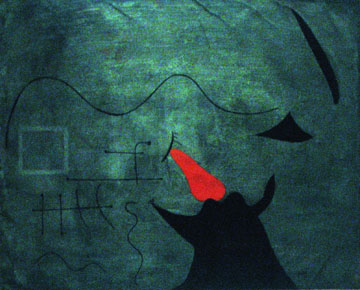
Joan Miró
Spanish, 1893-1983 (active France and Spain)
Chanteuse Romantique (Romantic Singer), 1939
watercolor and gouache on paper
13 × 16 in.
SBMA, Gift of Wright S. Ludington
1956.7.2

Undated photo of Miró
"I try to apply colors like words that shape poems, like notes that shape music." - Joan Miró
RESEARCH PAPER
THE ARTIST
Joan Miro is a rare example of an artist who had unvarying good fortune in his life even at a fairly young age. He owed his success to himself, his quiet persistance and dogged labor enabled him to overcome early difficulties and to rise above the customary formulas.
Miro was born in Barcelona, studied in Barcelona schools and painted his first oil in 1912. He first went to Paris in 1919 where he met Picasso and other artists painting in the surrealist style. From that time until 1933 he spent winters in Paris and summers in Montroig. During this time he had exhibitions in Paris, Brussells, New York and Chigago. In 1936 he left Spain due to the Civil War and returned to Paris where he remained until the advent of World War II, when he moved to Varengeville-sur-Mer.
While at Varengeville he painted a number of small playful pictures on canvas and burlap and felt this was a new stage in his work. In 1939 at the fall of France he fled back to Spain. While in Spain he was preoccupied with music, nature and the texture of surfaces on which he worked. The night, music and stars began to play a major role in his paintings. He was fascinated by light coming from windows in the Gothic Cathedral at Palma. He sat for long periods watching light and listening to strains of the organ, immersed in meditation, and absorbing impressions of music, poetry and the stimuli of the lights reflections on water and the Cathedral walls. The result of this withdrawal was a series of 23 small gouaches begun in Varengeville in 1939 and completed in Palma. It is possible the Santa Barbara Museum of Art work was among these.
These gouaches were exacting, both technically and physically, and each one took about a month to produce. The artist himself said he was most of all intent on compositional balance. Also at this time he produced a series called Constellations which achieved his intent in compositional balance. From this period on he worked in ceramics, murals, tapestries, costume design and collages, worked on burlap, canvas and paper. He made his first trip to the United States in 1947 and saw his work become de rigure of the establishment - a status symbol - and for these he received large commissions.
In Paris during the 20's Miro pioneered the development of Biomorphic Surrealism - charactarized by blob like free forms applied to canvas. These do not literally represent specific things but can be made to suggest living organisms from amoebas to people. The Biomorphs came to New York and affected virtuaIIy every American artist who worked on the visual frontier. The vitality of the Biomorph was domesticated into kidney shaped swimming pools and coffee tables of the 50’s designs. Miro's interpretation of Biomorphism was more radical than Arp’s hard edges shapes and expressed his philosophy regarding the interaction of man with nature literally - they were symbols of the generative procession of nature.
THE PAINTING
At about the time Miro painted Romantic Singer, he is quoted in an interview with James Sweeney as saying: "At Varengeville in 1939 began a new stage in my work - It was about the time when war broke out - I felt a deep desire to escape. I closed myself within myself purposely. The night, music, stars began to play a major role in suggesting my paintings." Romantic Singer would appear to be borne from some of this philosophy. The large black figure in the foreground draws us into the picture, further pulling the eye inward with the use of the bright red blob of color. The black figure could represent the singer with arms upraised. The configuration of the lines - straight and curved are seen in several of his paintings done at this time and seem to hold the composition together. This is sparse in its contents compared to some of his other works where canvases are entirely covered in a more decorative effect. The entire structure is covered with watercolor and gouache. The background appears dreamlike, with the blending of black, blue, white and grey creating a center of pale grey shadowing to darker grey. Two strong accents are created by black slashes on the right side of the painting. The use of lines; curved, decorative and straight balances the strong red and black forms.
CONCLUSION
Miro attempted to create art based on pure imagination which existed outside logic or reason. He used the technique of automatic drawing, in a trancelike state, demonstrating the influence of Kandinsky.
Miro was a highly imaginative man influenced by landscape and environment around him. The importance of his contacts with the Surrealists and their ideas is also evident in his work. Miro was disturbed about the war at the time "Romantic Singer" was painted. His work "Still Life With Old Shoe" (done in 1937) is a tragic and forceful work of his emotions about the war. It was perhaps a deliberate foil to Picasso's "Guernica", but "Romantic Singer" makes no such strong statement. Many of Miro's paintings are whimsical, playful. Although sometimes it is difficult to attach meaning to them, they are a pleasure to view for their content, design and color. The statement made by William Wilson of the Los Angeles Times, that "he was one of the longest lived children" aptly describes this great artist and his work.
Prepared for the Santa Barbara Museum of Art Docent Council by Jane Morris April 1988
